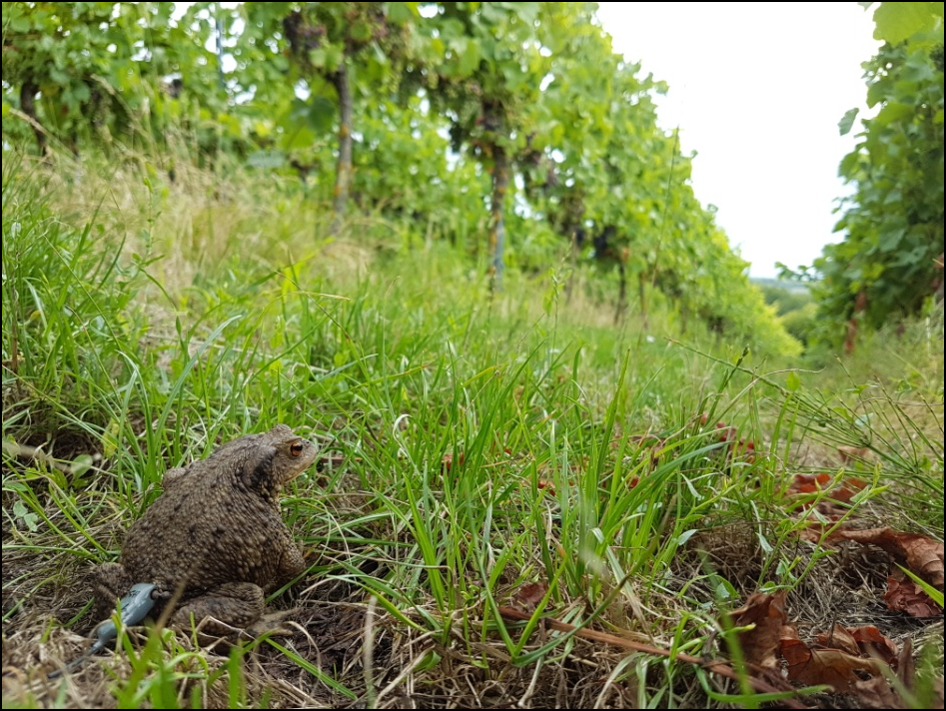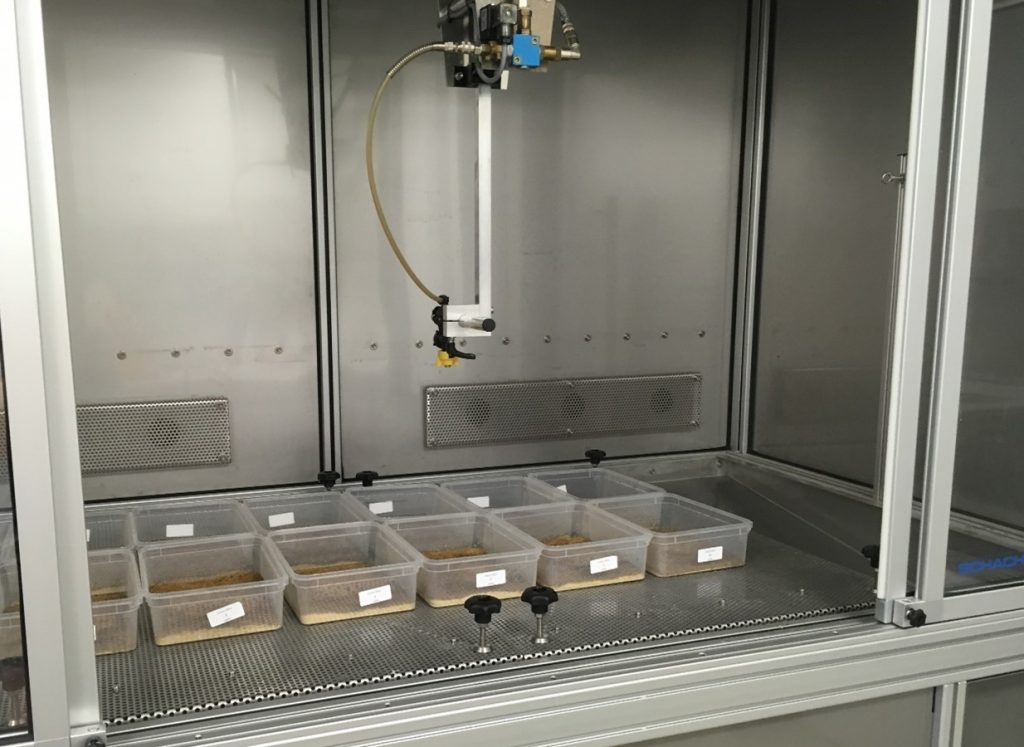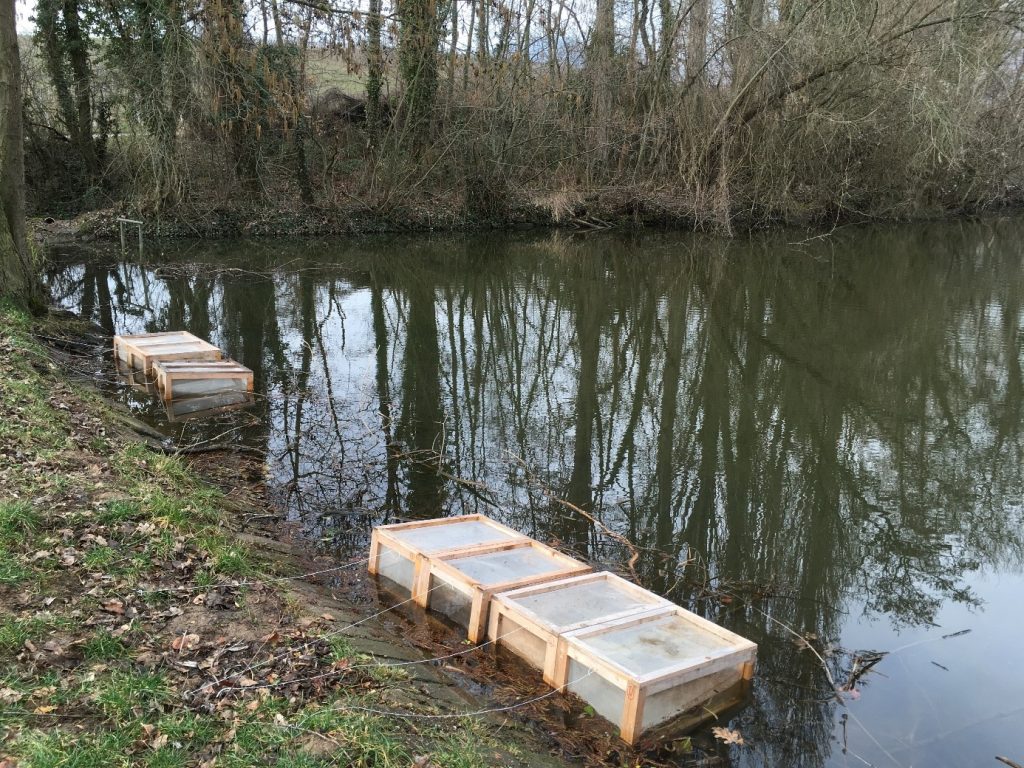In this post, Christoph Leeb and Elena Adams summarize three new papers on the effects of pesticides on amphibians, which will inform ongoing developments of pesticide testing and environmental risk assessment strategies in the European Union.
About 40% of the area of the whole European Union (EU) is used for agriculture, of which two thirds are cultivated with crops that receive one or more pesticide applications per season. Breeding ponds of amphibians are often located within or near agricultural landscapes, which is why amphibians likely come into contact with pesticides and contaminated soils, as larvae, juveniles, and adults. Pesticides can have adverse effects on amphibians and are recognised as one of the major factors for the observed global amphibian decline.

How are toads dealing with living in a pesticide-contaminated landscape?
In a previous study, we investigated if adult common toads (Bufo bufo) can be found in vineyards during their terrestrial post-breeding migration, which would indicate potential contact with pesticides applied on the vines. Using telemetry, Christoph could show that toads can indeed be found directly in the vineyards, although they tended to avoid vineyards as habitat. However, we were unable to conclude if this avoidance is only due to habitat characteristics (e.g., bare soil and dry conditions) or if it is, at least partly, caused by the applied pesticides. To find answers, we designed a laboratory experiment to investigate if common toads are avoiding soil that is contaminated with pesticides.
Troubleshooting the experimental set-up: How can we follow toads in their movement?
The plan was to use test areas where exactly one half of the arena is contaminated with a pesticide and one half is uncontaminated. Then, a toad should be placed in the middle of the arena and we would note the half where the toad would spend most of its time. What sounded like a simple experiment turned out to be more difficult and complex than expected. We realized quickly that adult toads could not be used for this experiment, because they are difficult to keep in the laboratory and because the test arena would have to be quite large which would complicate pesticide applications. Thus, we decided to use juveniles with a size of about 10-20 mm, and Petri dishes as test arenas with a diameter of 20 cm.

The next problem was the pesticide application. Our first idea was to use plant sprayers, so we drove to different DIY stores and bought literally every type of plant sprayer we found. We tested about 15 different sprayers, but every sprayer had its weaknesses and we were unable to apply the exact same amount of pesticide on several arenas. Luckily, we got the information from our collaboration partner in this study, the Julius-Kühn-Institute in Siebeldingen, that they just got a brand new laboratory spray application system that we could use for our experiment.
We aimed to investigate the side choice of the toads not only at one point in time but over 24 hours, which is why we needed a camera setup that is able to film the toads non-stop and also during the night. After trying different cam recorders, equipment for surveillance purposes, and even thinking about programming a recording app for smartphones, we came up with the idea to use raspberry pies, small single-board computers, with a camera module, and to use infrared light during the night that cannot be sensed by the toads, but by the cameras. As this setup is quite cheap (< 100 € for each camera set-up) we were able to buy several cameras to film up to 16 toads at the same time. After solving all the problems, we were ready in July 2018, just in time for juvenile toad collection.
Following the tracks: So, did toads avoid pesticides?
We tested if toads avoid pesticides using four conventional and three organic pesticide formulations at 100% (all) and 10% (only conventional pesticides) of the maximum recommended field rates. All tested formulations are regularly used in vineyards. We used the animal tracking software EthoVision® XT to analyse the video footage. By comparing the percentage of time the toads spent on the contaminated side over 24-h with a random side choice (50%), we found evidence for the avoidance of the folpet formulation Folpan® 500 SC, the metrafenone formulation Vivando®, and the glyphosate formulation Taifun® forte at maximum recommended field rates for vine and a trend for avoidance of Wettable Sulphur Stulln (sulphur). No avoidance was observed when testing Folpan® 80 WDG (folpet), Funguran® progress (copper hydroxide), SpinTorTM (spinosad), or 10% of the maximum field rate of any formulation tested. In the choice tests in which we observed an avoidance, toads also showed higher activity on the contaminated side of the arena.
As video analysis with tracking software is not always feasible, we further tested the effect of reducing the sampling interval for manual data analyses. We showed that one data point at every 15 or 60 minutes poses a risk of overlooking a weak avoidance behaviour.
Toads avoid several pesticides: Why should we care?
Given that agriculture is such a dominant type of land use in many regions in the EU, what does it mean for amphibians if they avoid pesticide-contaminated soil surfaces? Well, the pesticides could contribute to a chemical landscape fragmentation for amphibian populations, which could result in a reduced gene flow affecting the persistence of populations over a longer time period.
What happens if amphibians come into direct contact with pesticides?
Now that we know that amphbians obviously avoid pesticides, in a second experiment we investigated the effects of two different viticultural folpet fungicide formulations (the granular formulation Folpan® 80 WDG and the suspension concentrate Folpan® 500 SC) on juvenile common frogs (Rana temporaria). We chose this species because the research group around Carsten Brühl demonstrated that juvenile common frogs can be highly sensitive to different pesticides, whereby direct overspraying can result in a high mortality. Folpet formulations are the most commonly used fungicides in German vineyards and can be used up to 8 times with an interval of 7-12 days.
Skin contact to pesticides can make frogs slower and less efficient in catching food, and for some, be deadly
In our experiment, juvenile frogs’ skin was exposed to soil contaminated with 50% of the recommended field pesticide rate for 48 hours. As this kind of exposure represents a very realistic scenario and we did not expect high mortality, we initially aimed to use our camera set-up to investigate sublethal effects on the movement and feeding behaviour after the exposure. However, to our astonishment, dermal contact exposure to contaminated soil surfaces lead to mortality rates of 13-17% for Folpan SC and 17-100% for Folpan WDG. The exposure to Folpan WDG resulted in decreased moved distances of surviving juveniles. Moreover, the exposure to Folpan WDG and Folpan SC lead to reductions of 20% and 47% in the number of consumed Drosophila melanogaster, a yummy food source for frogs, respectively. Additionally, for both fungicide formulations, frogs needed more time to catch the first fly.

Our results show that commonly used fungicides in vineyards might induce severe mortality in amphibians – further accelerating amphibian declines. Folpet is applied many times throughout the growing season, making direct contact of frogs very likely. Additionally, surviving juveniles suffer from sublethal effects like impairments of activity and predation behaviour, which could have both immediate and long-term individual fitness effects.
Can pesticide contamination affect reproduction and thereby the next generation of amphibians?
To investigate potential adverse effects of long-term exposure to viticultural pesticides on the reproductive capacity of amphibians, we left the lab and conducted a semi-field study in pesticide uncontaminated and contaminated ponds near Landau which are inhabited by common toad populations. For this, we captured reproductively active common toad pairs of each population and kept them in net cages until spawning.

Toads from more contaminated ponds showed an increased fecundity (more eggs) but decreased fertilization rates (fewer hatching tadpoles) as well as lower survival rates and reduced size of tadpoles. These results suggest that the higher exposed populations suffer from long-term reproductive impairments. In combination with the determined acute toxicity effects observed in the above-mentioned study, the detected reproduction effects pose a serious threat on amphibian populations in agricultural landscapes.
Take-home messages
Combining the results from our studies, we conclude:
- Avoidance and reproduction are endpoints that should be addressed in future risk assessment procedures
- Pesticide applications should be reduced at least during the migration of adult and presence of juvenile amphibians to reduce the pressure on declining amphibian populations

For further reading, have a look at our recently published papers:
The paper “Avoidance behavior of juvenile common toads (Bufo bufo) in response to surface contamination by different pesticides” was authored by Christoph Leeb, Sara Kolbenschlag, Aurelia Laubscher, Elena Adams, Carsten Brühl and Kathrin Theissinger, and published open access in PLOS ONE.
The paper “Dermal fungicide exposure at realistic field rates induces lethal and sublethal effects on juvenile European common frogs (Rana temporaria)” was authored by Elena Adams, Verena Gerstle and Carsten Brühl, and published open access in Environmental Toxicology and Chemistry.
The paper “Pesticide exposure affects reproductive capacity of common toads (Bufo bufo) in a viticultural landscape” was authored by Elena Adams, Christoph Leeb and Carsten Brühl, and published open access in Ecotoxicology.
Thank you to Sara Kolbenschlag and Verena Gerstle, who both did an amazing job during their master theses, helping out with these projects.
